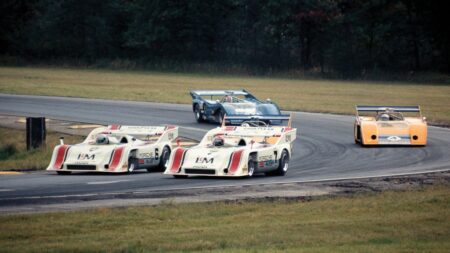
Days of thunder... from 8am-11pm
Behind every driver is a team, from design engineers to sweeper-uppers, but we don’t often get to hear from, or even about, them. Here’s a chance for the people who…
Did any racing car enjoy such a long and distinguished career as Porsche’s 956/962? The answer has to be no.
A machine that was designed for the new Group C category in 1982 claimed a first Le Mans 24 Hours victory on its debut and was still at the forefront six seasons later. And it kept on racing — and winning — long after that.
The statistics of the 956 and its long-wheelbase cousin, the 962, are impressive: six Le Mans wins and, over in the USA, five victories at the Daytona 24 Hours and four at the Sebring 12 Hours. There were four world championship drivers’ titles, and then three titles in IMSA.
The car — powered by a flat-six, originally intended for IndyCar racing — can claim almost 300 race victories around the world during a career lasting deep into the 1990s.
Yet the importance of the car transcends its success. Once customer cars came on stream for the 1983 season, it became a staple of the World Endurance Championship grid and later, after the introduction of the 962 in 1984, in the IMSA Camel GT Championship. Privateers could buy a turnkey car, take on the factory and have a fighting chance of winning.
Joest Racing did just that first time out with its 956 at the Monza 1000Km in April ‘83. It made a habit of vanquishing the Rothmans-sponsored factory cars over the years, most famously at Le Mans in 1985.
The importance of the Porsche prototype to worldwide sportscar racing resulted in an industry growing up around the car. A total of 188 956/962s were built, yet nearly 80 of those never saw the inside of Porsche’s Weissach factory. Customer teams on both sides of the Atlantic began commissioning their own tub on which to hang Porsche running gear, sometimes with aero or suspension revisions to boot.
“A road-going 962 went to Le Mans aiming to win the GT class, but won overall”
Perhaps the most amazing thing about the 956/962 given its stellar career is that it was designed and built in the space of eight months. The project wasn’t signed off until the summer and the beginning of the company’s financial year on August 1, and the first car was testing by the end of March. That wasn’t bad considering it was Porsche’s first monocoque chassis, and its first car with ground-effect aerodynamics.
The 956 didn’t win on its debut at the Silverstone 6 Hours in 1982, a bizarre regulatory twist saw to that. The fuel allocation for a six-hour race was, in something of an oversight, the same as for a 1000km event, and six hours around ‘old’ Silverstone was a lot further than 1000km. Jacky Ickx and Derek Bell aboard the solo entry were told by the architect of the 956, Norbert Singer, ahead of the race that they wouldn’t be on the top step of the podium. He was right.
But the new Porsche did win next time out at Le Mans, taking a one-two-three result. It would be beaten just twice in the world championship up to the end of ‘84. It was still the dominant car through the ‘85 and ‘86 seasons, until Jaguar and then Sauber-Mercedes got up to speed.
Victory at Le Mans in 1987 wouldn’t be the last big win. Joest triumphed at Daytona in 1991 before Porsche hurriedly put together a Le Mans campaign in 1994 around a road-going version of the 962 produced by privateer Jochen Dauer. It went aiming for GT honours, but ended up winning overall.
That wasn’t the end for the 956/962. Remarkably the design would notch up its final Le Mans start four years later. Singer’s design had graced the grid of the 24 Hours for an amazing 17 years in succession.
Price new £178,000
Price now £3-6.8 million
Engine 2.65-litre flat-six turbo
Power 620bhp
World championships 4
Wins 290
Verdict No sports car achieved so much for so long
Lasting appeal, but history is the key
It’s no secret that classic Porsche and race car values have grown, and the 956 is no exception. Including the later 956B there were 28 956s produced; 18 were delivered to customers and 956-001 through to 956-010 were for the Porsche works team.
Chassis 956-003 was described as “amongst the most important Porsches in existence” in the catalogue ahead of its $10.12m sale in 2015, but demand hasn’t always been as strong. In 2007 the same car went to auction with an unpublished estimate but did not sell. In the same month works stablemate 956-002 sold for £185,000 highlighting that the success of 956-003 is financially tangible.
In February 2014 chassis 956-004 sold for £1.96m. Non-works chassis 956-110 went to auction in October 2018 and while it failed sell, it had a high bid of £2.73m, which is the most recent indicator for current values.
The 2015 sale of 956-003 suggests that the success of each vehicle is highly influential in the price achieved. Days of the sub-£200,000 956 are no more. An entry price of £3m would not seem unreasonable with works cars likely to attract a premium over this. At the time of sale chassis 956-003 was the most expensive Porsche ever sold.
Robert Johnson, Classic and Sports Finance
